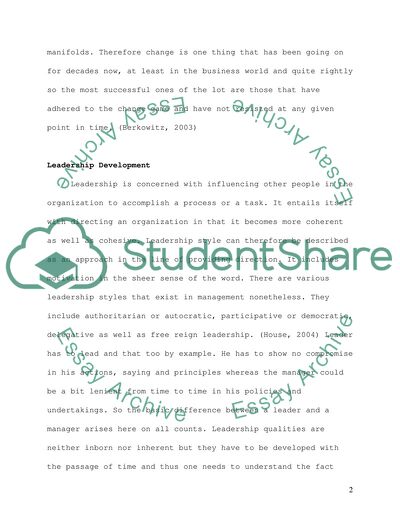
- Home
- Free Samples
- Premium Essays
- Editing Services
- Extra Tools
- Essay Writing Help
- About Us
- Studentshare
- Subjects
- Miscellaneous
- Literature Review - Practices in the field of Organizational Development
Literature Review - Practices in the field of Organizational Development - Essay Example

- Subject: Miscellaneous
- Type: Essay
- Level: Undergraduate
- Pages: 4 (1000 words)
- Downloads: 0
- Author: gutkowskiabraha
Extract of sample "Literature Review - Practices in the field of Organizational Development"
(Wilson, 2004) Businesses which stagnate over a period of time and do not change because of one pressure or the other usually die out quickly. The ones that have existed thus far have relied a great deal on the phenomenon attached with change and consistent upgrading of the needs as put forward by the business and its norms. The employees have stood up and got noticed, they have done their share of work in a more effective and efficient manner as well as raised their productivity levels manifolds.
Therefore change is one thing that has been going on for decades now, at least in the business world and quite rightly so the most successful ones of the lot are those that have adhered to the change game and have not resisted at any given point in time. (Berkowitz, 2003) Leadership is concerned with influencing other people in the organization to accomplish a process or a task. It entails itself with directing an organization in that it becomes more coherent as well as cohesive. Leadership style can therefore be described as an approach in the line of providing direction.
It includes motivation in the sheer sense of the word. There are various leadership styles that exist in management nonetheless. They include authoritarian or autocratic, participative or democratic, delegative as well as free reign leadership. (House, 2004) Leader has to lead and that too by example. He has to show no compromise in his actions, saying and principles whereas the manager could be a bit lenient from time to time in his policies and undertakings. So the basic difference between a leader and a manager arises here on all counts.
Leadership qualities are neither inborn nor inherent but they have to be developed with the passage of time and thus one needs to understand the fact that it requires strenuous exercise and a certain set of power that is needed
...Download file to see next pages Read MoreCHECK THESE SAMPLES OF Literature Review - Practices in the field of Organizational Development
Exploring how HR practice can drive the innovation in Abu Dhabi Education Council
Assessment of the Organizational Development
The Learning Organisation (HRM)
Knowledge Management Internalization in an Organization
Critique of Human Resource Management
The Organizational Culture and Business Internationalization
Keeping Information System Alive in Social Services Department
Change Management in Organizational Development

- TERMS & CONDITIONS
- PRIVACY POLICY
- COOKIES POLICY